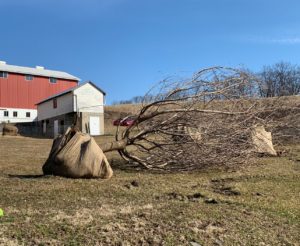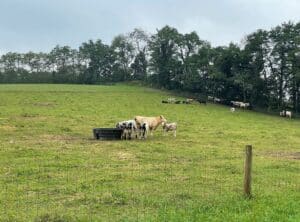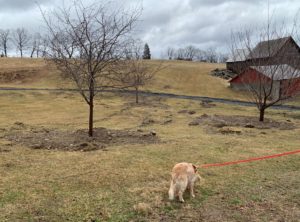Hello, fellow lovers of all things green,
Early Spring, after the ground thaws, is ideal for transplanting many deciduous and evergreen trees and shrubs before they break dormancy. It’s the second-best time in my book. The first best time is after the leaves drop or when they go dormant. That way, the roots, which remain active all winter long, will have time to settle in some before they put energy into new growth. However, there are plants with “thick and fleshy roots,” per Penn State’s Extension office, such as Oak, Birch, Hemlock, Magnolia, Tulip Poplar, Rhododendron, and Flowering Dogwood that do better transplanted in the Spring.

A rule of thumb is to dig a root ball eight to twelve inches wide for each inch of the transplant caliper.
While walking Miss Ellie past a farm that changed hands a handful of years ago, I noticed large cherry trees in the field with root balls loosely wrapped in burlap. The trees were about six to eight inches in caliper. I’ll admit seeing them lying there for a few days tugged at my heart, but at least they had the burlap for protection. And based on their intended placement, the new farm owners were thoughtful about where to plant the trees.
As for people, the stress is less when a new home is ready.
As with any new planting, please choose a location that fits its cultural requirements, such as sun versus shade, soil pH, moisture level, and wind tolerance. The cherry trees will help shade the goats, and the sunny spot will be a happy home for the transplants. Although, It would have been better if they dug the holes before excavating the trees so they could put them immediately into the ground. Like humans, the stress of moving is less if the home we’re moving into is ready for us and there isn’t a dramatic adjustment to an uncomfortable new environment.
When planting plants from a nursery, dig a hole two to three times the width of the root ball and the height of the root ball. Be sure the soil is moist but not overly wet, as it will cause soil compaction, inhibiting airflow to the roots. The same is true when relocating woody plants. The objective is to keep the root ball intact. Otherwise, the roots could break, killing the tree.
How to relocate woody plants
A rule of thumb for trees and shrubs you wish to transplant is to dig a root ball eight to twelve inches from the trunk for each inch of the caliper, the trunk’s diameter at chest height. The ball should be four to six feet for the farmers’ six-inch caliper trees, requiring a machine. For ambitious hand diggers, stick with transplants no more than two or three inches in caliper and recruit some strong helpers.
Before you lift your newly dug tree out of the hole, rock it to one side, tuck burlap under the ball, and tip to the other side to create a wrap, tying the top loosely with the twine. Carefully lower the tree into the new hole, straighten it, and carefully put the soil back, tamping it but not overly compacting it.
Cut away the exposed burlap and twine at about two-thirds to the top, then finish backfilling. Fertilizing is a no-no now as it adds stress to the already stressed transplant. But topping the disturbed soil with three inches of hardwood mulch, keeping it away from the trunk or stems will help retain moisture. Proper moisture levels for the first two years of a transplant are critical.
Transplants have double-duty
While early transplants will have a double duty—recovery and new growth—their resilient nature will prevail if we do our part, treating them with kindness and respect, much like people.
There have been changes on that farm in the last five years. One of the beautiful transplanted cherry trees survived. They built a building next to where the cows are to sell their goods. But the cows are in what looks like an acre of land, and their field is dirt much of the year with mud and puddling water after rain. I’ve seen the cows drink from the puddles mixed with their feces. It’s sad to see. Jolee, my dear rescue dog after Ellie joined the angels, doesn’t like to walk that way, nor do I. Though recently, it looks like they are trying to solve the drainage problem, and hopefully, they’ll expand their grazing area too.

I admire how these farmers tend to their animals.
Jolee and I walk along another street where farmers raise cows free to roam in large fields that they rotate. One field has two elderly cows living out their years. It warms my heart.
Garden Dilemmas? AskMaryStone@gmail.com and your favorite Podcast App.
Enjoy another story sure to bring a chuckle – Spring Garden Honey-dos.
There’s more to the story in the Garden Dilemmas Podcast (a soothing 10 minutes):



